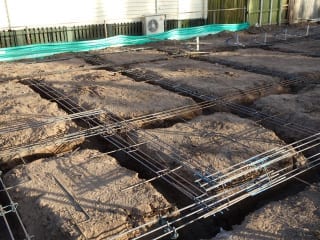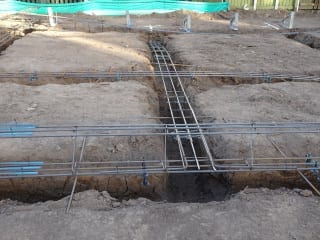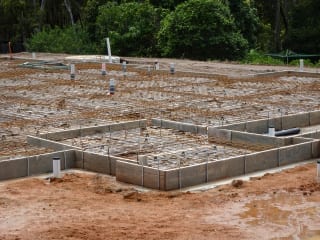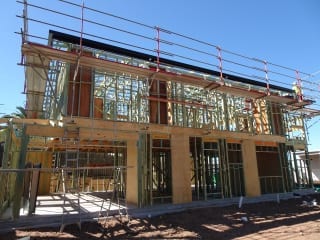Before building: What you need to know about new house construction & inspection stages.
So you have decided to have your dream home built, well here are a few tips on new house construction & inspection stages. QBIS.
First of all, the soil must be tested:
- Soil must be tested by a Geotechnical Engineer to determine type of soil.
- Footings and slab are then designed, based on soil test results.
- Results are then passed onto a licensed Builder, Designer or Architect.
- Consult a Builder, Designer or Architect to draft plans to submit to the Council for approval.
First stage of building, inspection required.
Example of the first stage with strip footing dug out with reinforcing tied and ready to be fitted.
This without a doubt would have to be the most important stage to have inspected and must be carried out by a competent structural engineer.
Example of second stage of inspection.
Concrete has been poured to form the strip footings with formwork fitted to the perimeter to support concrete for the slab. Reinforcing for the slab has been fitted at the correct heights and tied. The plastic vapor barrier is in place, below the reinforcing.
Third stage of inspection.
Completed frame with all components in place, braced and secured, ready for roof cladding and brickwork.
This must be thoroughly checked against the finalised Council approved plan, before any plaster is fitted.
Stages of inspections required during the construction process:
Each stage must be checked against the current and final Council approved plan and specifications, before they are covered.
- Footings (and if required) slab. This must be carried out after preparation and before the concrete is poured.
- The following must be in place at this stage: Formwork (to support the concrete). Termite treatment (or alternative barriers). Plastic membrane (vapor barrier). Reinforcing (supported and tied).
- Framing, before sheeting is attached and covering the frame.
- Items that must be checked at this stage: Tie-down securings. Size, span and spacing of structural components. Bracing walls and their securings.
- Practical completion, ready for handover of the building to the client.
- Items that must be checked at this stage: Operation of all installations. Whether standard of finishings are acceptable.
Refer to the QBCC acceptable tolerances guide booklet to gain a better understanding of what is acceptable or not in finishings, also how to determine.
What must be checked at these inspection stages?
- Footings: Width &, depth. Reinforcing, dimensions, securing, locations (from top and bottom). Membrane, lap cover & damage.
- Slab: Depth. Reinforcing, dimensions, securing, locations (from top and bottom).
- Frame: Type of timber, dimensions and spacings. Bracing, type, location, securings. Lintels, sizes. Tie-down securings.
Extremely important: All of the building components must be checked against the Council approved plan and specifications to ensure they are the same. Also make sure any amendments have been Council approved.
Who is qualified to carry out these inspections?
- Licensed Certifier.
- Structural engineer.
- Anyone with the appropriate qualifications and insurance cover (check).
Who should not carry out these inspections?
- Licensed builders (without further qualifications and insurance cover) are not qualified to carry out inspections regarding: Footings, slab, frame, bracing, securings.
- Check their insurance limitations, if they claim they can.
Who would I recommend to perform these inspections on your behalf:
- Footings: Qualified structural engineer.
- Slab: Qualified structural engineer.
- Framing: Qualified structural engineer.
- Completion (handover): Qualified Builder.
- Maintenance: Cosmetic items, yourself.
Areas they should access:
- Property: surface drainage.
- Building exterior: Design faults.
- Roof exterior (where safe to access): Broken tiles, inadequate roof flashings, poor finish.
- Roof interior (where possible): Construction. Accumulation of insulation around electrical fittings.
- Building interior: Sagging ceilings (where more than acceptable). Leaking from bathroom, laundry, toilet, kitchen. Obvious unacceptable finishes.
What to expect from a completion (handover) inspection report and inspector:
- Major problems.
- Suggestions on preventative maintenance.
- Access to the inspector for advice after the inspection.
Completion (handover) Inspections, what to watch out for:
- Minor items of no consequence, meaningless items.
- Omission of major items.
- Areas they did not attempt to access.
Maintenance period, after moving in:
- Compile a list of what you consider to be defects.
- Pass your list onto the builder
- If your builder is not co-operative then you may need to contact the QBCC for advice on your course of action.
New house construction & inspection stages, related information:
Qld Government Acceptable Standards and Tolerances guide




